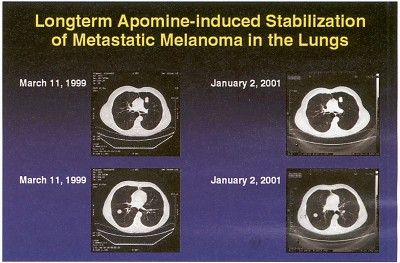Apomine Stabilizes Melanoma, Has Potential for Prevention
NEW YORK-A potential chemopreventive agent against melanoma stopped metastatic spread in some patients in a phase I clinical trial, according to a report presented at the Chemotherapy Foundation Symposium XIX (abstract 69). The agent,
NEW YORKA potential chemopreventive agent against melanoma stopped metastatic spread in some patients in a phase I clinical trial, according to a report presented at the Chemotherapy Foundation Symposium XIX (abstract 69). The agent, Apomine (SR-45023A), is being developed by Ilex Oncology, San Antonio, reported David S. Alberts, MD, professor of medicine, pharmacology and public health and director of Prevention & Control, Arizona Cancer Center.
Initial studies of the agent, he said, were directed toward preventing breast cancer metastases. "It’s active in preclinical models by the oral route against a wide variety of human cancers in vivo," he said. The agent is also active if applied topically, he noted.
A bisphosphonate ester, Apomine activates the farnesoid X receptor (FXR) to induce apoptosis, in addition to downreg-ulating the mevelo-nate isoprenoid cholesterol (MIC) pathway, Dr. Alberts explained. "It is extremely well tolerated in animal models using single- and chronic-dose administration," he said.
In the phase I clinical trials of oral Apomine at the Arizona Cancer Center and University of Texas San Antonio Cancer Center, three different dosing schedules were used: a 14-day schedule in 19 patients, a continuous schedule in 23 patients, and a weekly schedule in 11 patients, Dr. Alberts reported. Doses ranged from 100 to 700 mg/d orally on the 14-day and continuous schedules, and from 400 to 2,100 mg/wk orally on the weekly schedule.
Of the nine patients in the trial with melanoma, three achieved stable disease. In one 63-year-old man, stabilization of pulmonary metastases has continued for 33 months and 41 cycles of Apomine (see Figure for two views). Before entering the Apomine trial, the patient had undergone five chemotherapy regimens for his melanoma. He continues to receive Apomine on a schedule of 50 mg twice daily for 14 days every 21 days.

A woman, age 32, with a large anterior abdominal wall mass had stable disease for 6 months with nine cycles of Apomine therapy. She previously progressed on three other regimens. A man, age 43, treated with five prior regimens had stable disease for 3 months with four cycles of Apomine.
The study, Dr. Alberts reported, showed that the maximum area under the Apomine plasma disappearance curve was reached at a dose of 100 mg twice daily and fell off thereafter. The reason, he suggested, is probably bile "sludging" that occurs because the FX receptors are also bile acid receptors. "When you get to a certain concentration of Apomine," he said, "you’re really sludging bile so it’s counterproductive."
Prevention Studies
Using a TPras transgenic melanoma mouse model developed at the Arizona Cancer Center by Dr. Marianne Broome-Powell, Apomine was tested in mice with DMBA-induced cutaneous human melanoma. Topical applications of Apomine or perillyl alcohol, three times a week for up to 35 weeks, were started 4 weeks before the melanoma-induction process was begun.
In an untreated control group, 100% of the mice developed melanoma. Perillyl alcohol reduced the melanoma "take" by about 25%, Dr. Alberts reported. With Apomine, the reduction was 80%.
"I’m very interested in developing topical agents that could be put into sun screens but actually have some anticancer effect, not just a sun-blocking effect," Dr. Alberts said in an interview with ONI. Apomine, he added, "is by far the most active agent that we’ve ever seen" in preventing melanoma development in the transgenic mouse model.
"Basically," he said, "I think that we now have some real reason to want to study this as a preventive agent. If it is stabilizing disease in metastatic and drug-resistant melanoma, and has the amount of activity we see in the transgenic model, it really requires us to evaluate it as a potential preventive agent. It’s by far the leading drug that I’ve studied. I’ve studied all the retinoids. I’ve studied every conceivable topical formulation, and so I’m very excited about this."
Newsletter
Stay up to date on recent advances in the multidisciplinary approach to cancer.